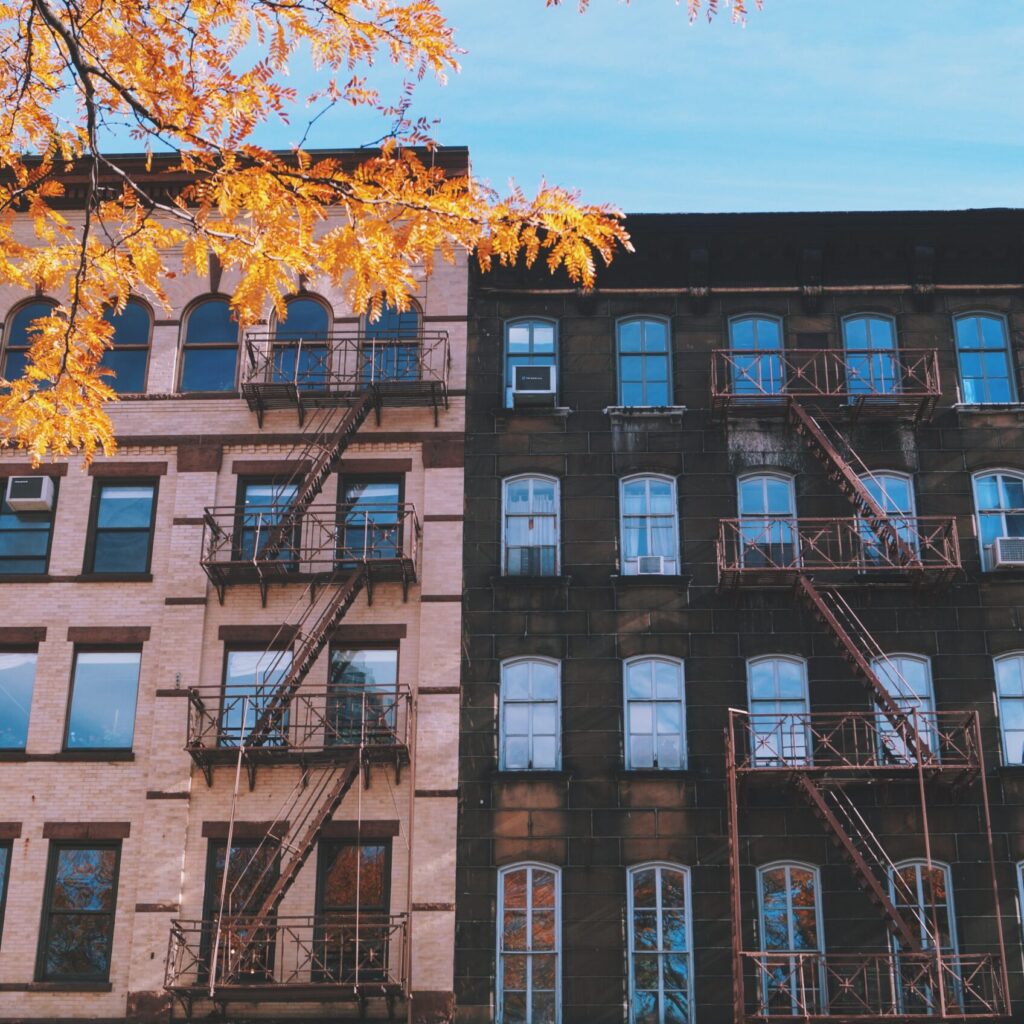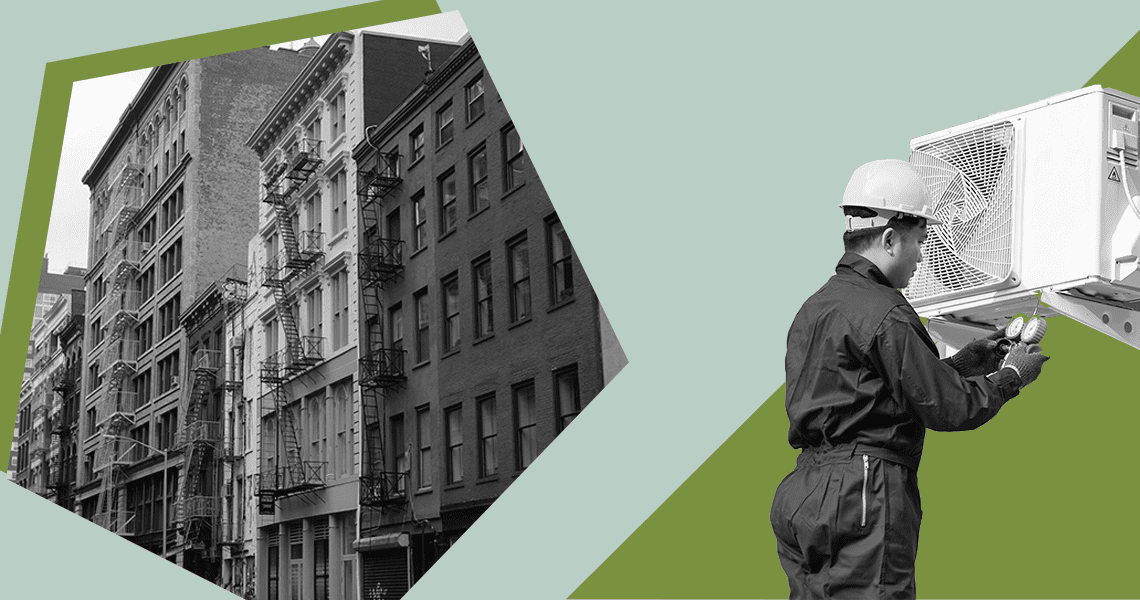LL97 set to drive 25,000 retrofit projects in 5,500 prewar low-rise buildings by 2030
Original publication by Urban Green Council • November 8, 2023
Earlier this year, we found that most multifamily buildings have a straightforward and actionable path to 2030 LL97 compliance. Now, we’re taking a deeper look at the retrofits required for the most common multifamily building sector: prewar, low-rise buildings with one-pipe steam heating distribution systems.
The first LL97 compliance period is here and building owners across the city are planning short- and long-term retrofit strategies. In the law’s implementation, including through recent proposed rules, the NYC Department of Buildings has prioritized giving building owners the flexibility and resources to get on track for 2030. As the law’s sponsor, Costa Constantinides, famously quipped, “[We] don’t want your money, [we] want your carbon. That is the goal.”1
But how will those 2030 carbon savings translate to investment, retrofit projects and green jobs in the most common multifamily building type?
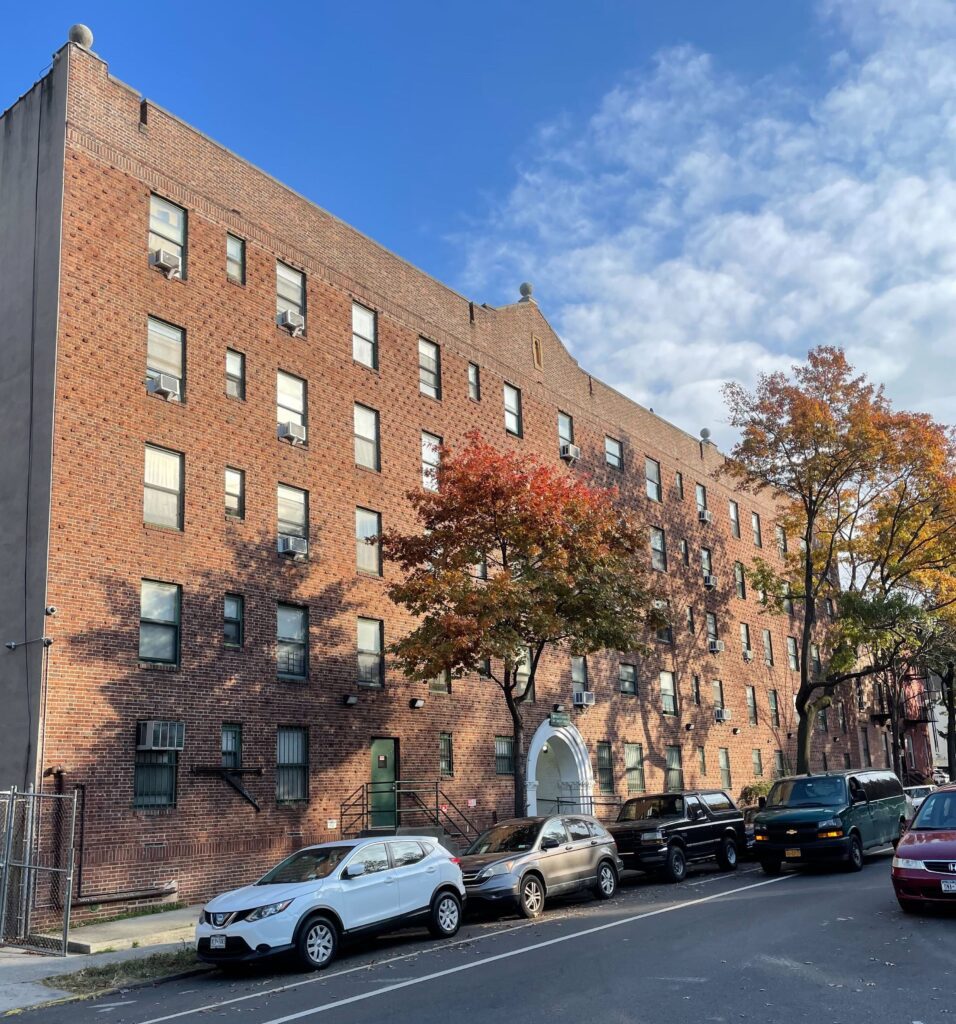
2030 progress for this sector:
- 25,000 retrofit projects in 5,500 prewar, low-rise properties
- Over $300M of total investment in building improvements
- 270,000 tonnes of carbon saved per year, equivalent to taking 60,000 gas-powered cars off the road annually
Our analysis shows that LL97 is set to drive about 25,000 building retrofit projects in 5,500 prewar, low-rise multifamily buildings by 2030. These retrofit projects represent a range of in-building work to reduce energy use and carbon emissions. Nearly all prewar low-rise steam buildings will make common efficiency upgrades, like installing boiler sensors and controls, and vents to balance heat throughout the building. These upgrades to energy-intensive building systems are vital to cutting carbon emissions now.
And as new incentives and credits are becoming available, some buildings can take on future-proofing retrofit projects like electrification. Specifically, we estimate almost 50 prewar low-rise steam buildings will electrify space heating and up to 500 will install heat pump water heaters before 2030. These early electrification projects will help catalyze the market and workforce to scale heat pumps over the coming decades.
One-quarter of LL97 properties are prewar, low-rise steam buildings
Prewar low-rise multifamily buildings with one-pipe steam heating distribution systems make up around 35 percent of all multifamily properties covered under LL97, and nearly a quarter of total covered properties.
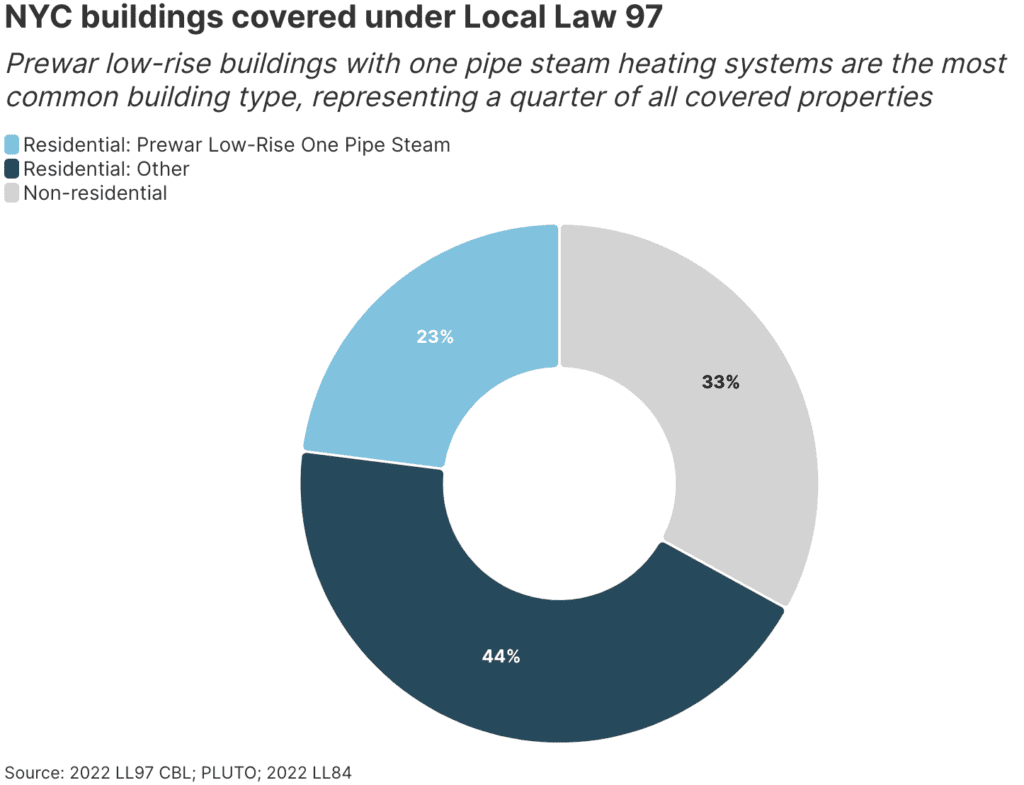
The buildings in this sector are also relatively homogenous, with many consistent characteristics and systems. They are typically 6 stories or fewer, have masonry exterior walls with no insulation, rely on natural ventilation (like opening a window), and operate a central boiler that supplies both steam to radiators for heating as well as domestic hot water (DHW) for showers and faucets. This consistency means that most buildings will need to implement a combination of a few similar retrofit projects.
With this standardization in mind, we partnered with Cadence OneFive to estimate the total number of retrofit projects that will be needed to get these buildings to their 2030 targets. The results help put the size of the LL97 retrofit market in perspective, pave the way for building owners to greenlight upgrades, and inform contractors and tradespeople about the market opportunity.
Buildings will primarily focus on energy efficiency projects in the short term
To start this analysis, we segmented the roughly 5,500 prewar low-rise steam properties into four retrofit groups based on the type and scale of retrofit work they’ll need to comply with LL97 in 2030 (you can find more information about these retrofit groups in Part 1 of this analysis).
LL97 Retrofit Groups
Prescriptive path
- Primarily buildings with a significant number of rent-stabilized units
- Must complete a bundle of cost-effective energy efficiency upgrades
Well on the way
- Require less than a 20 percent carbon reduction to meet 2030 limits
- Simple cost-effective energy efficiency measures should be sufficient
Tough but doable
- Require a carbon reduction of between 20-40 percent to meet 2030 limits
- Will likely require a package of retrofit projects that could include electrification of hot water production
Leapfrog potential
- Require a carbon reduction of more than 40 percent to meet 2030 limits
- The most effective path is for these buildings to invest in full or partial electrification of their heating and hot water systems
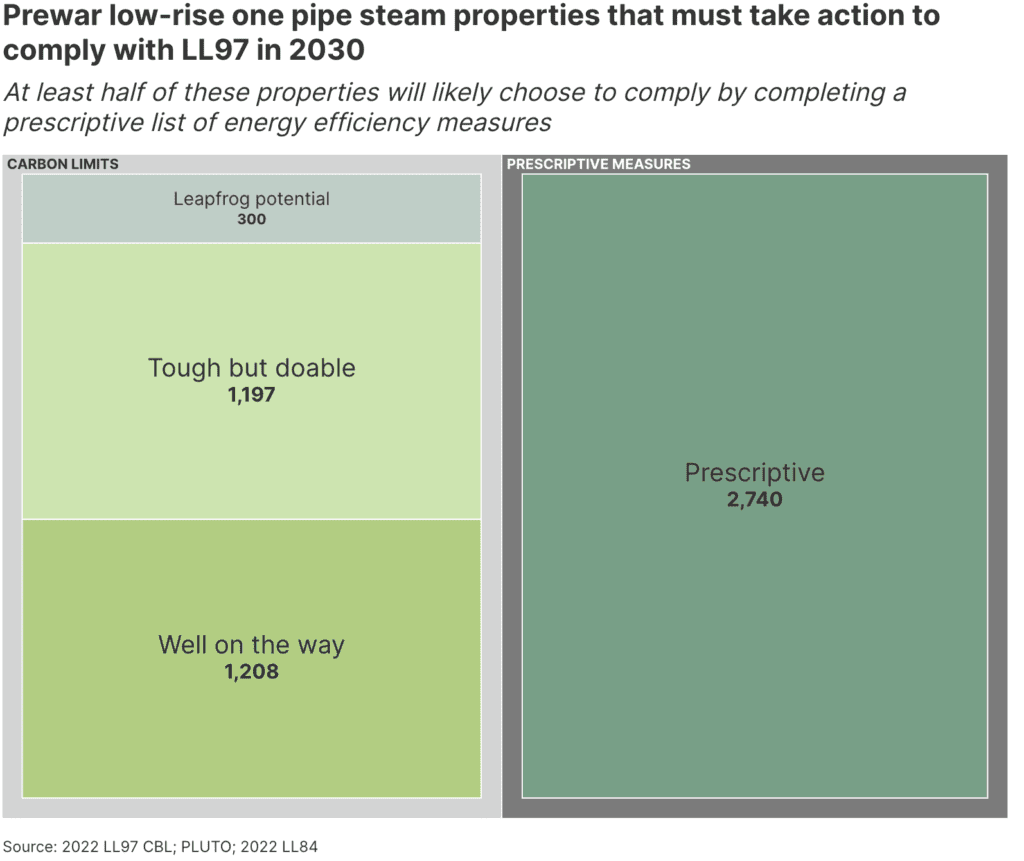
A majority of prewar low-rise buildings are eligible to comply with LL97 through the “Article 321 prescriptive path requirements” since they are considered affordable housing—primarily buildings with more than 35 percent rent-stabilized units. This classification allows a building to implement a list of energy conservation measures by the end of 2024 rather than meet a specific carbon limit (the first case study at the end of this article details a likely retrofit pathway for these buildings).
On the other hand, 1,500 prewar low-rise buildings—classified as Leapfrog Potential or Tough but Doable—must reduce their emissions by more than 20 percent to meet their 2030 LL97 carbon limit. Doing so will likely require a package of retrofit projects spread out over multiple years, including potentially installing heat pumps to produce their hot water (the second and third case studies focus on buildings implementing electrification to comply with LL97).
To tally the number of retrofit projects anticipated across all prewar low-rise steam buildings, we looked at each building’s LL97 2030 retrofit group and its current heating fuel type: gas, No. 2 fuel oil, or No. 4 fuel oil. We also considered factors incentivizing early electrification, including funding from state and federal programs and two local provisions affecting NYC buildings:
Factors encouraging electrification
Phaseout of Fuel Oil #4
Independent of LL97 requirements, buildings that use No. 4 fuel oil for heat or hot water must transition to another fuel source starting between July 1, 2024 and July 1, 2027, when their current boiler permit is up for renewal. Over 1,000 covered buildings currently use No. 4 fuel oil for heat or hot water and the most effective long-term path for these buildings is to leapfrog fossil fuels altogether and electrify their space heating and hot water systems.
Beneficial electrification credit
The latest LL97 proposed rules offer a new beneficial electrification credit for properties that install and use heat pumps or heat pump water heaters before 2030. This credit can be applied to mitigate penalties up until 2036. The framework for this credit is a thumb on the scale for earlier action by 2026 with the credit diminishing both in size and duration for later installations in 2027, 2028 and 2029.
Based on all these factors, we used Cadence OneFive’s software platform, Momentum, to identify representative prewar low-rise buildings and worked with the Cadence OneFive team to create work scopes—packages of retrofit projects—and cost estimates. We then scaled these workscopes and cost estimates to all 5,500 prewar low-rise steam buildings that need to take action to comply with LL97 in 2030.
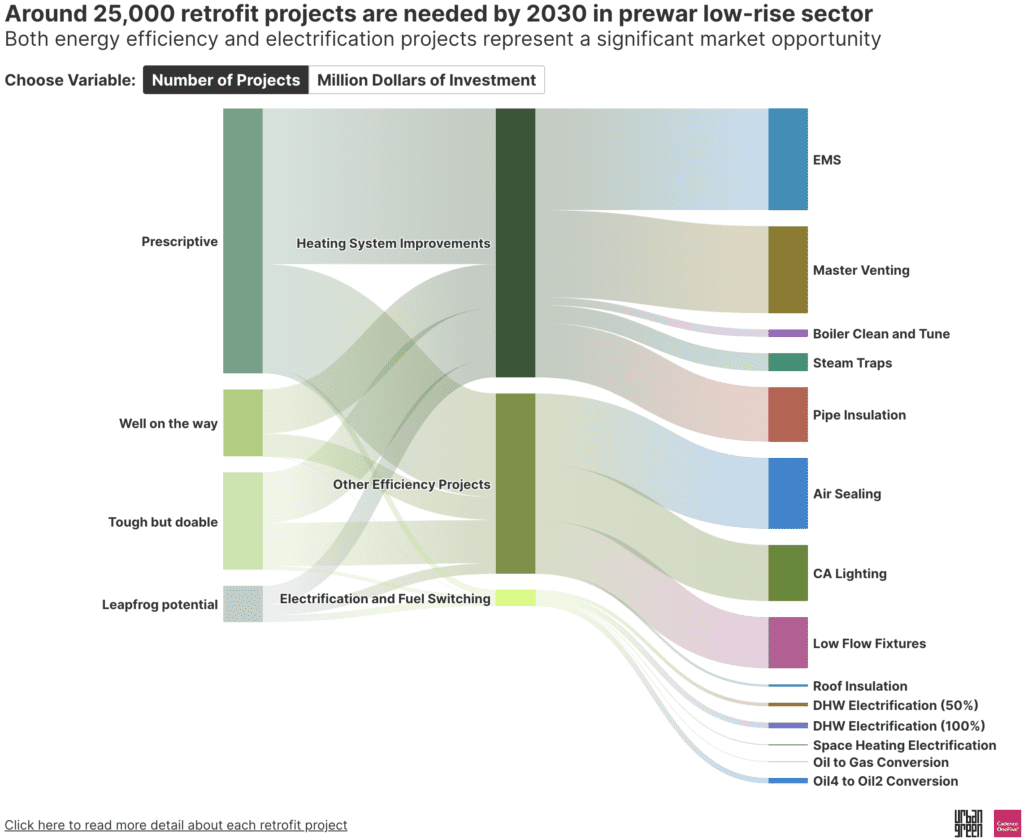
Improvements to existing steam heating systems represent over half of the retrofit projects for this sector. Cost-effective improvements to boilers and maintenance operations are still the most efficient way for most buildings to quickly reduce carbon emissions, since about half of their energy use goes to heating. Other key takeaways from this analysis include:
- Incremental electrification: Buildings are more likely to choose DHW electrification instead of space heating electrification to comply with LL97 in 2030 based on cost, complexity and tenant impact.
- Forward-looking investment: More total investment will go into electrification projects than upgrades to current fossil fuel building systems since each electrification project carries a much higher cost.
- Adaptable efficiency: Certain efficiency projects—including air sealing and installing low-flow aerators and showerheads—are “no regrets” solutions that lower energy demand for heating and hot water, which makes future electrification projects cheaper and means they will put less strain on the grid going forward.
- Green workforce opportunity: The growing market for common efficiency retrofit projects—like installing energy management systems, insulating pipes and installing low-flow fixtures—is an opportunity to bring more New Yorkers into the green workforce.
Over $300 million of investment in prewar, low-rise buildings by 2030
The retrofit projects we’ve highlighted for prewar low-rise buildings vary significantly in terms of the amount of work and investment they require. For example, we estimate that the total investment associated with fewer than 500 electrification projects is greater than the investment needed for all 2,740 buildings choosing to comply with prescriptive measures. While electrification is a much larger investment, these buildings will be well-positioned for long-term compliance with LL97.
Decarbonizing NYC’s buildings will require a mix of cost-effective investments to improve current building systems and large capital outlays to electrify over time. Both types of work improve the comfort and value of residential units, and there are increasingly generous government incentives to complete this work. The graphic below shows the amount of investment required for each retrofit group to reach their 2030 targets.
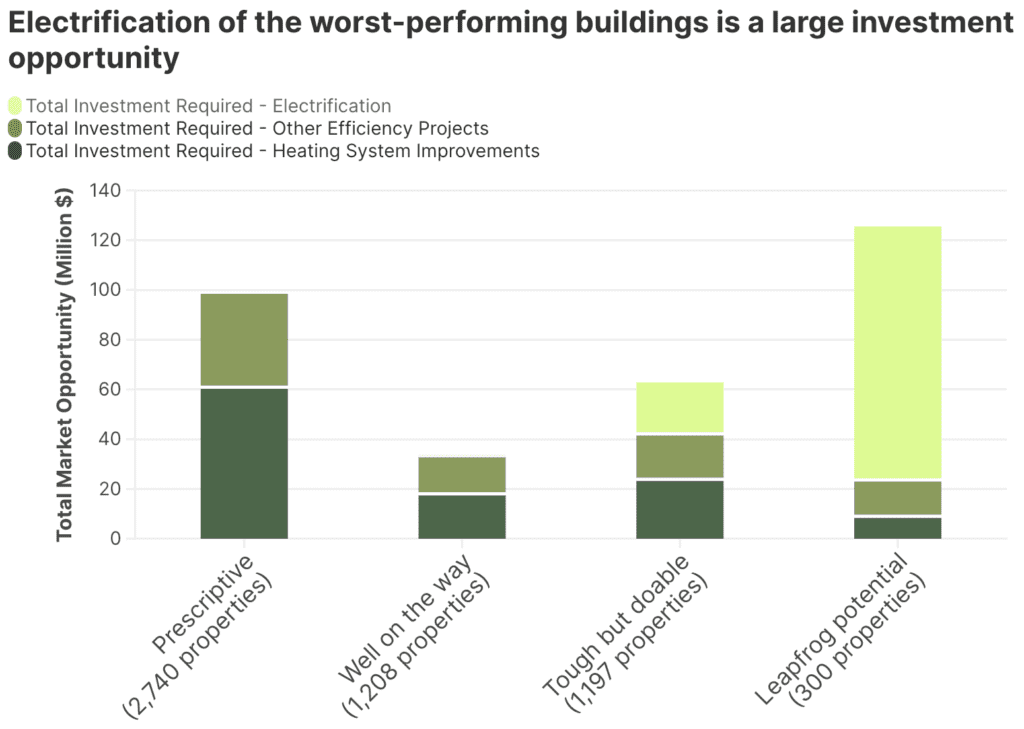
Explore the workforce needed for these projects through three case studies
It’s clear that pollution-reducing retrofits of prewar multifamily buildings represent a significant economic opportunity in NYC over the next decade. But who will do all of this work? NYSERDA’s New York Clean Energy Report estimates that there are currently 60,000 energy efficiency jobs in NYC. But this industry, alongside traditional building trades like plumbers, electricians and HVAC professionals, will need to grow to support building decarbonization in the short and long term.
The workers needed to complete this work depend on the extent of the retrofit projects required. For prescriptive path buildings, specialized energy efficiency providers and boiler technicians can complete this suite of upgrades over a month or two. But for buildings electrifying their heat or hot water systems, electricians, plumbers, steel fabricators and HVAC technicians are each needed for specific tasks. Coordinating activities across all these workers and building residents is time-consuming—full implementation can take up to six months to a year—but strong project management is crucial to ensuring resident satisfaction and realizing the targeted carbon reductions.
To highlight how this new green workforce will intersect with prewar low-rise building retrofits, we put together three illustrative work scopes based on Cadence OneFive’s analysis of real NYC buildings:
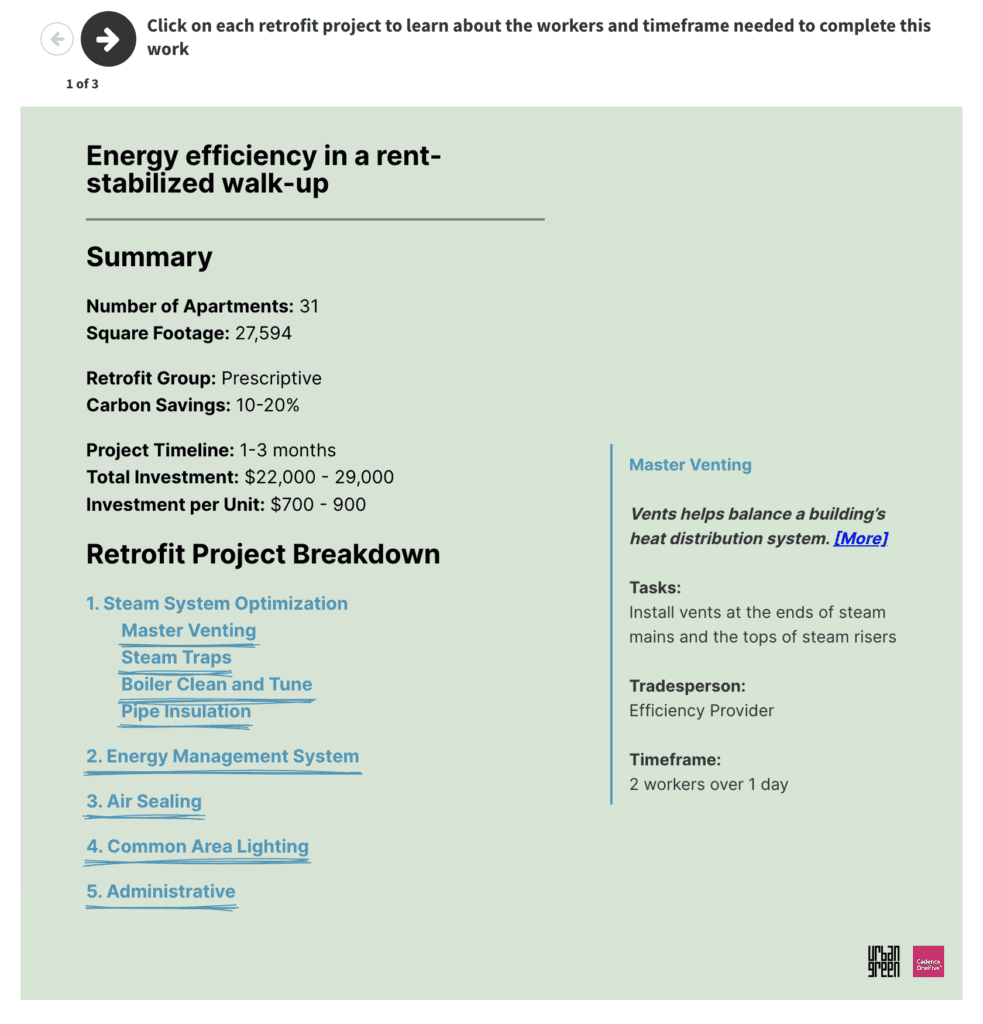
Conclusion
Multifamily building owners will choose a variety of paths to meet the 2030 LL97 limits, and there’s no way to perfectly predict the future. The landscape is already evolving—in just one example, New York’s Clean Heat for All Challenge could advance a scalable, lower-cost window heat pump solution applicable to many of NYC’s one-pipe steam buildings.
But no matter how LL97 implementation unfolds across all sectors, our analysis makes it clear: NYC is set for a major mobilization of in-building retrofit work and the associated workforce. As the retrofit market drives toward 2030 and beyond, industry experience, support and innovation will boost know-how and lower costs on the path to long-term LL97 targets.
Thank you to our thought partners at Cadence OneFive

References
1 https://politicsny.com/2019/09/27/three-climate-bills-enacted-during-climate-week/
Basic methodological notes for retrofit project analysis
- Prototype buildings were identified based on their retrofit group and primary heating fuel
- Knowledge of the current building systems and condition was limited to the basic characteristics and energy use available through public data. Some buildings could have already implemented suggested upgrades.
- LL97 2030 compliance scopes were created for each prototype building
- Workscopes are meant to give a sense of the likely mix of projects to inform an estimate of investment and workforce requirements to meet the aggregate LL97 requirements for this sector.
- These workscopes were primarily optimized for best return on investment, but other considerations—including multiple factors incentivizing electrification—were also considered.
- Some buildings with the option to comply via the Article 321 prescriptive path requirements were predicted to instead comply with a building carbon limit in 2030 due to this being the lower cost option after administrative costs were factored in.
- Prototype building workscopes were assigned and scaled to each applicable prewar low-rise property that is covered under Local Law 97.
- Workscopes and associated costs were aggregated for the entire building sector.
